25+ SAMPLE Construction Incident Report
-
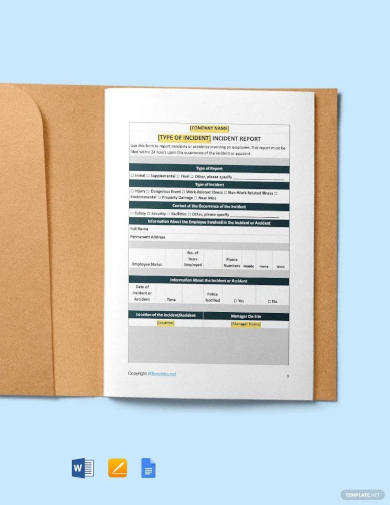
Sample Construction Incident Report Template
download now -
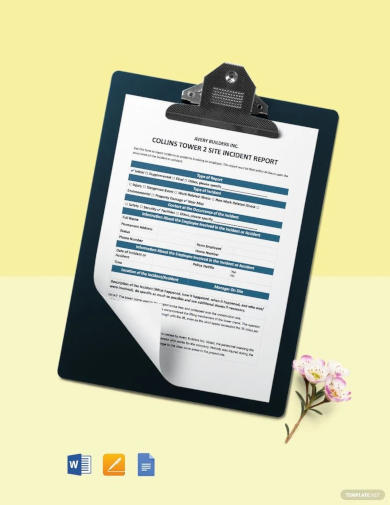
Construction Site Incident Report Template
download now -
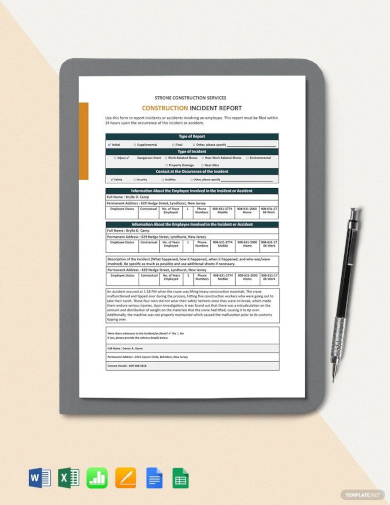
Construction Incident Investigation Report Template
download now -
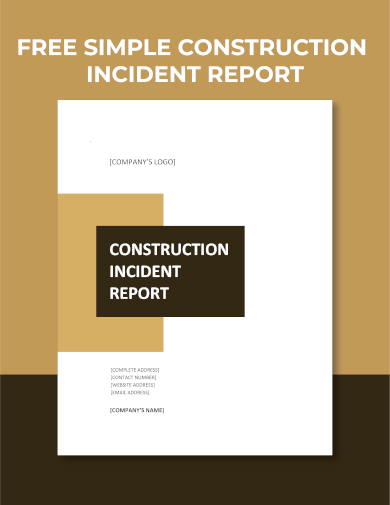
Simple Construction Incident Report Template
download now -
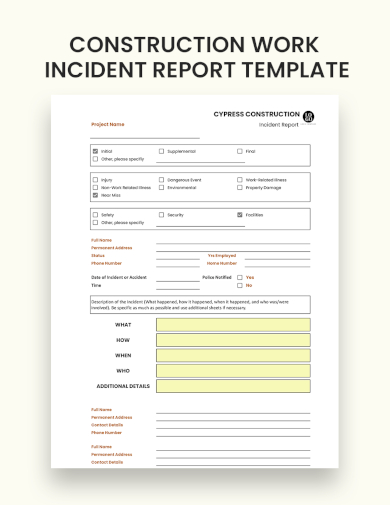
Construction Work Incident Report Template
download now -
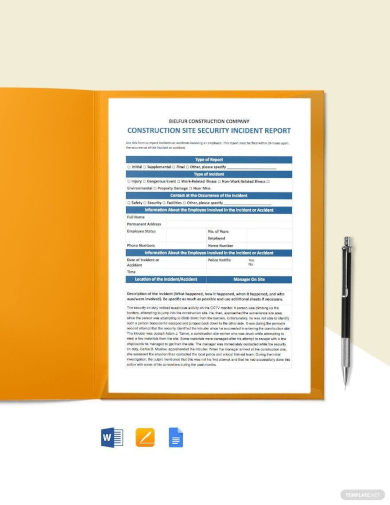
Construction Security Incident Report Template
download now -
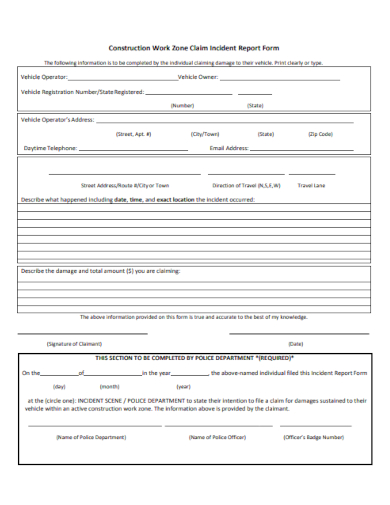
Construction Work Claim Incident Report
download now -
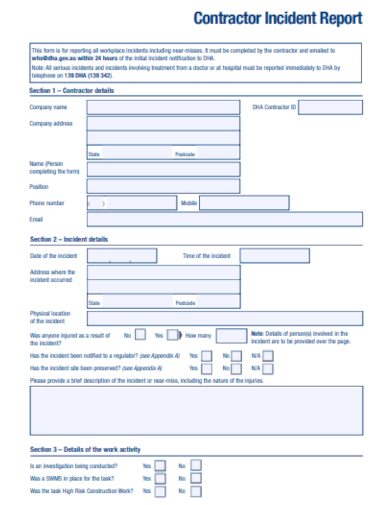
Contractor Incident Report
download now -
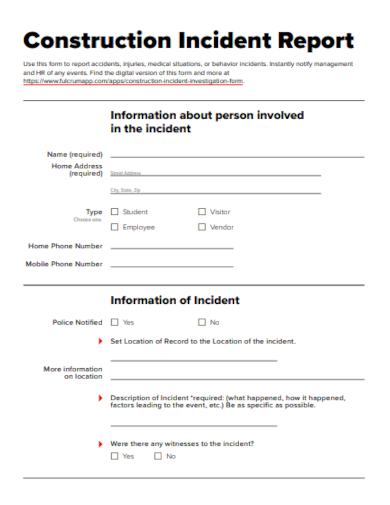
Construction Incident Information Report
download now -
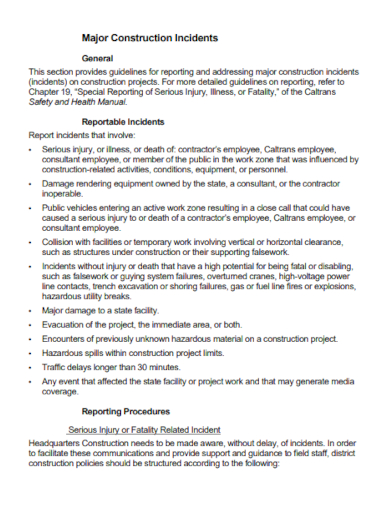
Construction Incident Reporting Procedure
download now -
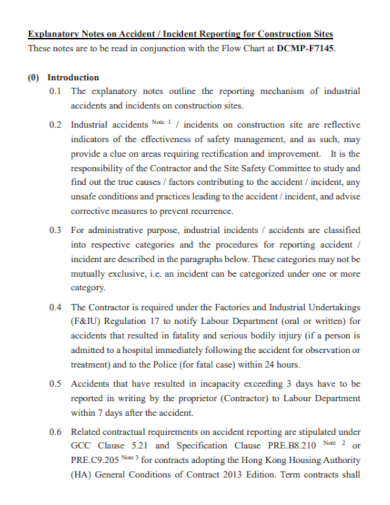
Construction Site Accident Incident Report
download now -
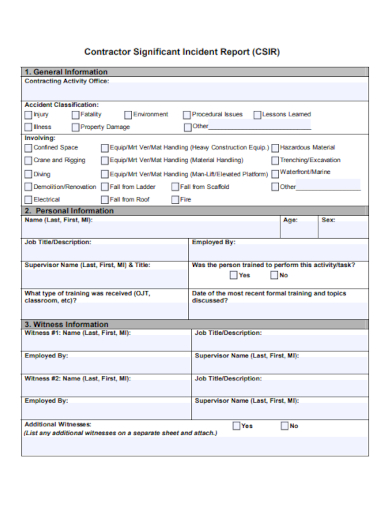
Contractor Significant Incident Report
download now -
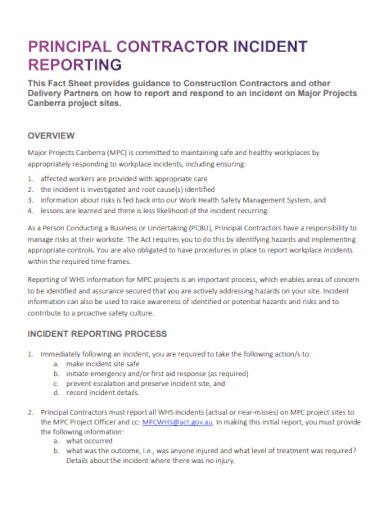
Principal Contractor Incident Report
download now -
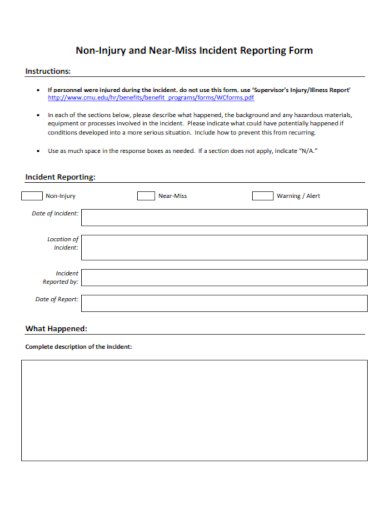
Construction Non Injury Incident Report
download now -
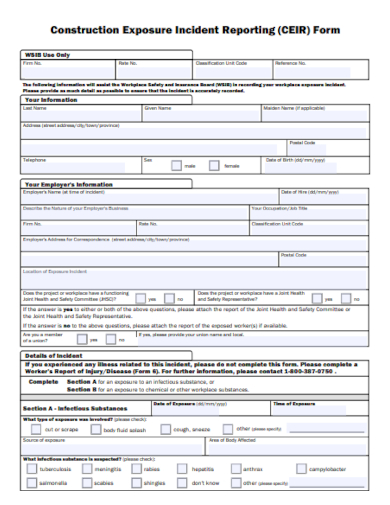
Construction Exposure Incident Report
download now -
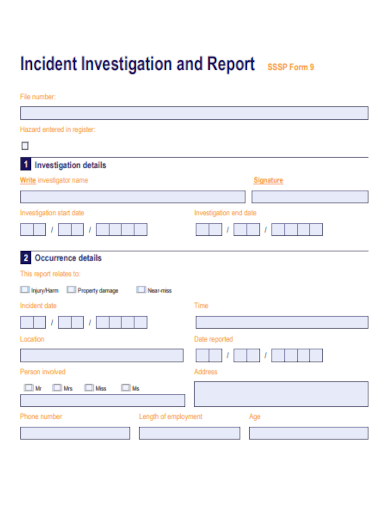
Construction Incident Investigation and Report
download now -
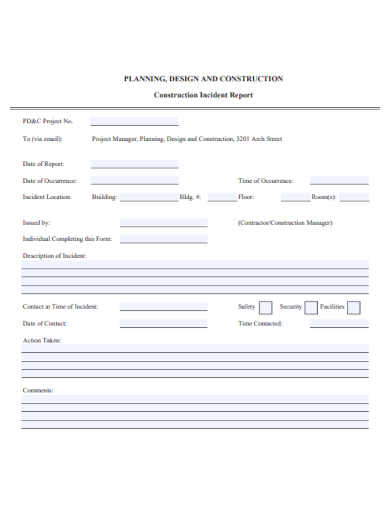
Design and Construction Incident Report
download now -
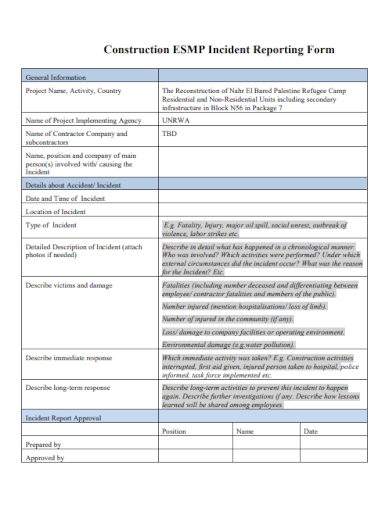
Construction Incident Reporting Form
download now -
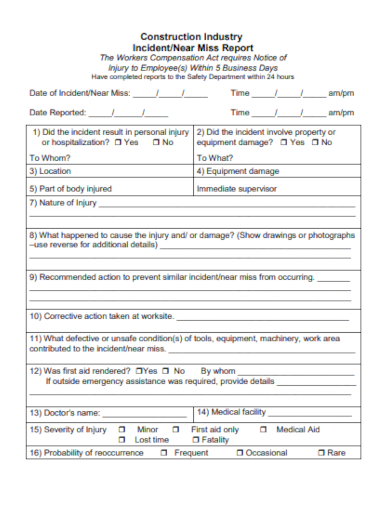
Construction Industry Incident Report
download now -

Construction Worker Incident Report
download now -
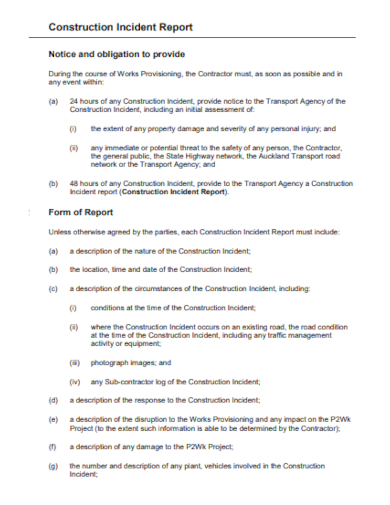
Printable Construction Incident Report
download now -
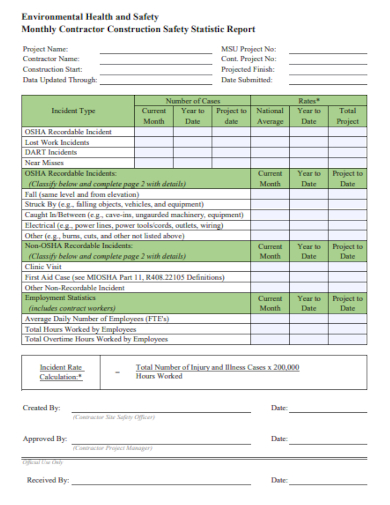
Monthly Construction Safety Incident Report
download now -
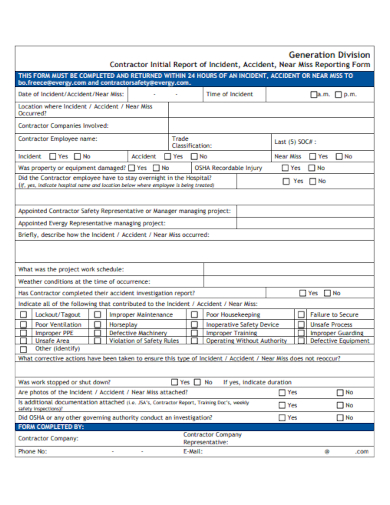
Construction Report of Incident
download now -
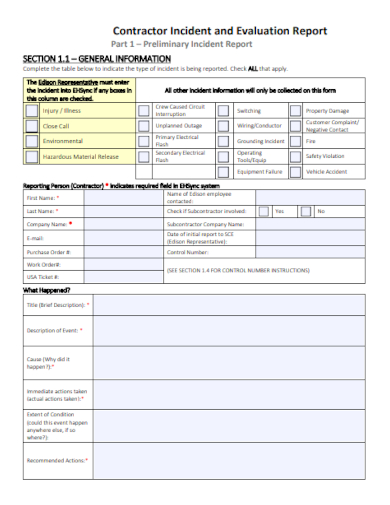
Construction Incident Evaluation Report
download now -
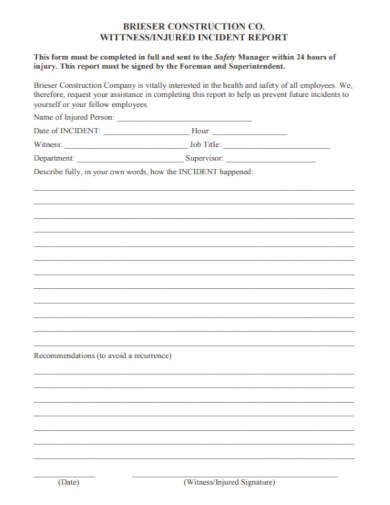
Construction Witness Incident Report
download now -
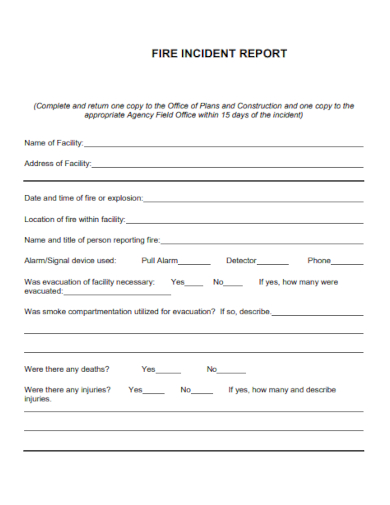
Construction Fire Incident Report
download now
FREE Construction Incident Report s to Download
25+ SAMPLE Construction Incident Report
Definition:
Understanding the Importance of a Construction Incident Report:
Key Components of an Incident Report:
The Significance of a Timely Report:
Drafting with Precision and Objectivity:
Review and Analysis for Continuous Improvement:
Leveraging Incident Reports for Improved Safety:
What details should be included about the injured party in the report?
How does the report help in identifying potential hazards in construction sites?
Why is the validation by a site supervisor essential in the incident report?
How do construction companies utilize incident reports for continuous improvement?
When should a construction incident report be filed after an onsite accident?
Definition:
A Construction Incident Report is a detailed document outlining any unforeseen events, accidents, or safety breaches that occur on a construction site. It serves to record the specifics of the incident, determine root causes, and recommend corrective actions. This report is essential for safety compliance, legal protection, and continuous improvement in construction safety protocols.
Understanding the Importance of a Construction Incident Report:
In the bustling environment of a construction site, safety remains paramount. Yet, despite stringent measures, incidents do occur. When they do, it’s vital to document every detail, not only for compliance and legal reasons but to foster a culture of continuous safety improvement. A Construction Incident Report is that crucial tool, serving as an invaluable reference for all stakeholders involved in a project.
Key Components of an Incident Report:
Identification Details:
Every incident report should begin with basic identification details. This typically includes information like the date, time, and location of the incident, as well as the names and roles of individuals involved. It sets the stage for readers to understand the context of the incident.
Narrative Description of the Incident:
A comprehensive, objective, and clear description of the incident is crucial. This section provides a sequential breakdown of events leading up to, during, and after the occurrence. All details, no matter how minor they might seem, can be essential for understanding the broader picture.
Witness Statements:
Collecting and documenting accounts from any and all witnesses provides a multifaceted view of the incident. These statements can be instrumental in piecing together an unbiased recounting of the event.
Immediate Actions Taken:
Detailing the immediate response to the incident gives readers an understanding of the severity and aftermath. This section can include interventions made, first aid administered, or any emergency services contacted and their response.
Visual Evidence:
Whenever possible, photographs, diagrams, or any other visual representation of the incident and the surroundings should be included. Visual aids can provide clarity, especially when dealing with complex scenarios or environments.
Root Cause Analysis:
This section dives into the underlying reasons or conditions that led to the incident. A thorough analysis can help identify operational or systemic flaws that need addressing.
Recommendations for Future Prevention:
After understanding the cause, recommendations can be made to prevent similar incidents. These might include changes in procedures, safety equipment upgrades, or training programs.
Signatures and Verification:
To ensure the accuracy and completeness of the report, it should be signed off by the individual compiling it and, if necessary, verified by a supervisor or higher authority. This adds a layer of accountability and validation to the document.
The Significance of a Timely Report:
A prompt incident report ensures that details are recorded while they are still fresh, and swift action can be taken. It serves multiple purposes including:
Prompt Identification of Issues:
A timely report ensures immediate recognition of problems, allowing stakeholders to understand the magnitude and implications of the incident swiftly. The quicker an issue is identified, the faster appropriate measures can be taken to address it.
Quick Response and Resolution:
When an incident is reported without delay, it paves the way for a rapid response. Whether it’s addressing safety hazards, providing medical attention, or rectifying a procedural error, timely action can prevent further complications and mitigate adverse outcomes.
Accurate Recollection of Details:
Memories can fade or become distorted over time. Submitting a report promptly ensures that details are fresh in the minds of those involved, leading to a more accurate and comprehensive account of the incident.
Legal and Compliance Implications:
In many industries, especially construction, there are legal and regulatory requirements for reporting incidents within specific time frames. A timely report ensures compliance, avoiding potential legal complications or penalties.
Stakeholder Trust and Transparency:
When incidents are reported promptly, it demonstrates a commitment to transparency and responsibility. This can enhance trust among stakeholders, including employees, partners, and clients, reinforcing the organization’s dedication to safety and integrity.
Data Collection and Trend Analysis:
Consistent, timely reporting allows organizations to collect data that can be analyzed for patterns. Recognizing trends or recurring issues can lead to proactive measures, preventing similar incidents in the future.
Protecting Organizational Reputation:
Timely reporting and swift action can limit negative publicity and potential damage to an organization’s reputation. Demonstrating a proactive approach to incident management can even bolster an organization’s image in the eyes of the public and industry peers.
Cost-Efficiency:
Immediate reporting can lead to quicker resolutions, potentially reducing costs associated with prolonged investigations, extended downtimes, or increased damage due to delays in response.
Drafting with Precision and Objectivity:
When creating an incident report, it’s paramount to remain unbiased and provide a factual account, refraining from speculating or placing blame. Clear and concise language ensures that all stakeholders, regardless of their familiarity with the incident, can understand the events and the potential implications.
Review and Analysis for Continuous Improvement:
Periodic reviews of incident reports can offer insights into recurring issues or trends. Analyzing these can pave the way for process improvements, enhanced safety measures, and updated training programs, fostering a safer and more efficient environment.
Assessing the Root Cause:
For continuous improvement, it’s imperative to delve beyond surface-level details and understand the underlying cause of an incident. By using root cause analysis tools like the “5 Whys” or Fishbone Diagrams, construction firms can identify fundamental issues leading to accidents, thus preventing their recurrence.
Trend Identification:
Consistently reviewing incident reports can help identify patterns or trends. For instance, if a particular type of accident frequently occurs at a specific project phase, it might indicate a broader systemic issue that needs addressing.
Employee Feedback:
Engage with workers on the ground. Their insights, often derived from firsthand experiences, can be invaluable. Workers might highlight operational gaps or suggest preventative measures that might not be evident at a managerial level.
Technology Integration:
Incorporate technology to automate the incident reporting and analysis process. Systems that utilize AI can rapidly sift through large amounts of data, highlighting areas of concern and suggesting possible solutions.
Training and Education:
Once patterns are identified, and root causes are understood, tailor training programs to address these specific issues. Regularly updating training material based on real-world incidents can make them more relevant and effective.
Feedback Loop:
Ensure there’s a system in place to share findings from the analysis with all stakeholders. This not only keeps everyone informed but also reinforces the importance of incident reporting.
Regular Audits:
Periodically, conduct safety audits and risk assessments to evaluate the effectiveness of implemented changes. This will help in gauging if the improvements are yielding desired results or if further tweaks are needed.
Benchmarking:
Compare your incident reports and safety practices with industry benchmarks or with peers. Understanding how you fare against industry standards can offer a clear picture of where improvements can be made.
Stakeholder Engagement:
Regularly engage with stakeholders, including clients, subcontractors, and regulatory bodies. Their external perspectives can provide fresh insights and might highlight areas previously overlooked.
Iterative Process:
Continuous improvement is an iterative process. Regularly revisit and revise strategies based on new incidents, changing regulations, technological advancements, or shifts in industry best practices.
Leveraging Incident Reports for Improved Safety:
Incident reports are not just about documenting mishaps; they’re a treasure trove of data. Analyzing these reports can offer insights into patterns, pointing to broader issues that might be overlooked in daily operations. By leveraging this data, construction companies can predict potential problem areas and take proactive steps.
Data-Driven Decisions:
By regularly compiling and analyzing data from incident reports, companies can identify patterns and trends that might not be evident from isolated incidents. This data-driven approach ensures that corrective measures target the most pressing and recurrent safety concerns.
Employee Training and Awareness:
Incident reports can be used as case studies in safety training sessions. By discussing real-life events, workers can better understand the consequences of neglecting safety protocols. Furthermore, it personalizes the safety message, making it more relatable and impact full.
Tool and Equipment Upgrades:
Reports can also highlight recurring equipment malfunctions or failures. Using this information, companies can prioritize equipment upgrades or replacements, ensuring workers have the best tools for the job, which function safely and effectively.
Revising Safety Protocols:
If certain safety procedures are consistently linked to incidents, it’s a sign they need to be revisited. Companies can leverage the information in reports to refine or overhaul existing safety protocols, ensuring they align with the on-ground realities.
Stakeholder Communication:
Sharing summarized findings from incident reports with stakeholders analysis, including clients, investors, and regulatory bodies, shows transparency and a commitment to safety. It reinforces the notion that the company takes incidents seriously and is proactive in its approach to prevent future occurrences.
Incentivizing Reporting:
Companies can leverage incident reports to introduce safety incentive programs. By rewarding workers for reporting incidents or unsafe conditions, it encourages a proactive safety culture where problems are highlighted before they escalate.
Enhancing Supervision and Monitoring:
If incidents frequently occur in specific areas or under certain supervisors, it might indicate a need for better supervision or more comprehensive monitoring tools in those areas.
Continuous Improvement Mindset:
Leveraging incident reports should be an ongoing process, not a one-time activity. By continuously referring to and learning from these reports, construction companies can foster a culture of continuous improvement, where safety standards evolve in line with the ever-changing nature of construction work.
What details should be included about the injured party in the report?
In the incident report, details about the injured party should include their full name, job title, contact information, years of experience, immediate medical actions taken, nature and severity of injuries, location on the construction site when the incident occurred, and any witnesses present during the incident.
How does the report help in identifying potential hazards in construction sites?
The incident report systematically documents the circumstances leading up to and surrounding the incident. By analyzing this data, construction managers can identify patterns, recurrent issues, or areas of high risk on the site. This aids in pinpointing potential hazards, allowing for proactive measures to prevent future accidents and improve overall site safety.
Why is the validation by a site supervisor essential in the incident report?
Validation by a site supervisor ensures the incident report’s accuracy and completeness. Supervisors possess a comprehensive understanding of site operations and can corroborate details provided. Their verification lends credibility to the report, ensuring that corrective actions are based on factual information and that potential liabilities or disputes are addressed appropriately.
How do construction companies utilize incident reports for continuous improvement?
Construction companies analyze incident reports to identify patterns, root causes, and potential hazards. By understanding the circumstances leading to incidents, they implement preventive measures, refine safety protocols, and enhance training programs. This proactive approach fosters a safer work environment, reduces risks, and promotes a culture of continuous improvement in safety practices.
When should a construction incident report be filed after an onsite accident?
A construction incident report should be filed immediately after an onsite accident. Prompt reporting ensures accurate recall of events, allows for swift corrective actions, and mitigates further risks. Immediate documentation also aids in medical interventions, legal considerations, and insurance claims, ensuring that all involved parties are informed and protected.
In conclusion, a construction incident report is indispensable in maintaining safety standards and ensuring compliance within the construction industry. As construction projects evolve, these reports serve as valuable references for future risk assessment report and mitigation strategies. By prioritizing documentation and analysis, professionals can foster safer work environments and uphold the industry’s reputation for operational excellence.
